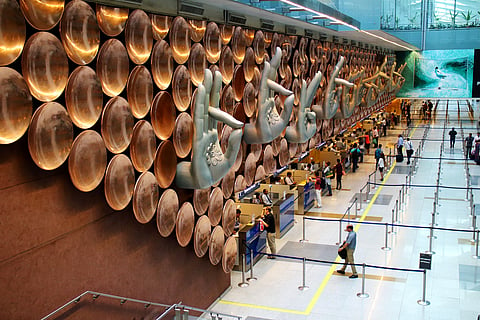
- Destinations
- Experiences
- Stay
- What's new
- Editor’s Picks
- Responsible Tourism
- CampaignsCampaigns
- Subscribe

On Friday, July 14, the Delhi airport opened its fourth runway and dual Eastern Cross Taxiways (ECT). This significant development will boost the capacity and operational efficiency of the largest airport in India. The airport is expected to handle up to 109 million passengers annually in the near future.
This is welcoming news at a time when air travel demand is on the rise in the country. In June, domestic air passenger traffic rose nearly 19 per cent year-on-year to around 1.25 crores.
A ceremonial water cannon salute was accorded to an Air India plane to mark the operationalisation of the fourth runway. Flight AI 821 took off from Delhi to Srinagar as a part of the inauguration.
Capacity Increase For Indira Gandhi International Airport
Indira Gandhi International Airport (IGIA) is the first airport in the country to have four runways and ECT. It handles around 1,500 aircraft movements every day. Currently, the capacity is 70 million passengers per year. However, with a new addition, the Minister boasted that Delhi airport will even beat Atlanta airport in its capabilities.
With the fourth runway and terminal expansion expected to be completed soon, Scindia said Delhi Airport's passenger handling capacity will increase to 109 million annually.
The fourth runway will also result in the airport being able to handle more flights. It will increase the capacity from 1,400 to 1,5000 aircraft movements to almost 2,000. Talking about the ECT, he also said that vehicles would be moving on the road below while planes would be taxiing on the ECT. He added that two wide-body planes, like A380 and B 777, can use the ECT simultaneously.
Benefits For Passengers
Scindia said the next challenge for the GMR Group is to ensure that the fourth terminal is operational by October, before the onset of the rush season.
IGIA is operated by the Delhi International Airport Ltd (DIAL), a consortium led by GMR Airports Infrastructure Ltd.
"We are in consultations with airlines so that you have a seamless travel journey with minimum connection time between domestic and international travel. Thereby regaining our pole position as an international hub, starting with Delhi and many more to come," the Minister added.
The ECT will connect the northern and southern airfields on the eastern side of the airport, allowing wide-body aircraft to land and take off easily. It will also reduce the distance an aircraft needs to cover after landing on the third runway and going to Terminal 1 (T1) from 9 kilometres to just 2 kilometres. This will save passengers a lot of time and make their experience much more enjoyable.
Additionally, the dual-lane ECT can handle wide-body aircraft, including A380 and B777 and B747.
Reducing Carbon Emissions
According to DIAL, the ECT is estimated to save around 350 kilograms of fuel every time an aircraft taxis through the runway from RW 29R to Terminal 1 and vice versa.
"This translates into a reduction of nearly 1,114 kg of CO2 emissions for each aircraft taxiing along this route. On an annual basis, the ECT is estimated to reduce emissions of approximately 55,000 tonnes of CO2 from aircraft," it said last week.
As per DIAL, 55,000 tonnes of CO2 emission is equivalent to planting about 15 lakh trees. Around 9,175 MT of fly ash has been used to construct the ECT.
A Promising Future
It has been announced that Air India, IndiGo, and Akasa Air have ordered new planes, which will increase India's fleet size to 1,500 planes in the near future. Additionally, the country's airports are projected to have an annual passenger handling capacity of almost 42 crore by 2030, a significant increase from the current level of 14.5 crore.
(With inputs from PTI)
Cover Photo Credits Gritsana P / Shutterstock.com
